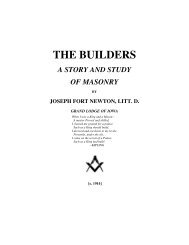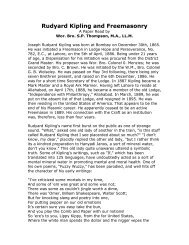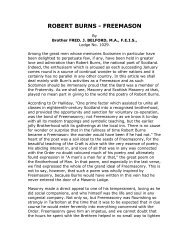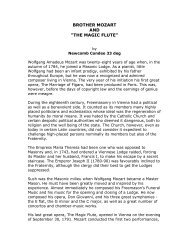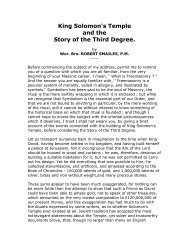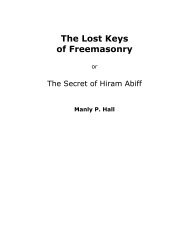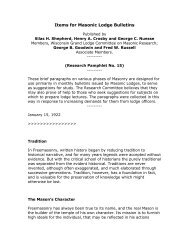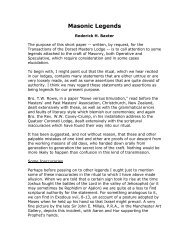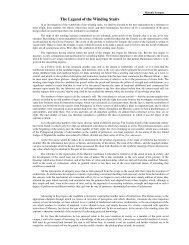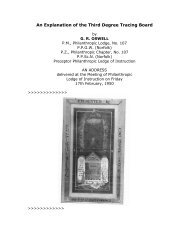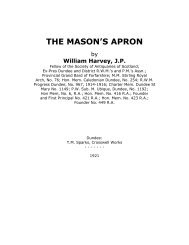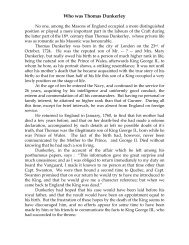Through the Key Hole - RoseCroix.org.au
Through the Key Hole - RoseCroix.org.au
Through the Key Hole - RoseCroix.org.au
You also want an ePaper? Increase the reach of your titles
YUMPU automatically turns print PDFs into web optimized ePapers that Google loves.
135<br />
THE POLYCRONICON<br />
By Keith Stockley<br />
Written by a monk, Ranulf Highen, who died in 1500, how do you<br />
think this chronicle with an almost unpronounceable name, is connected<br />
with Masonic history?<br />
41<br />
“ The room facing south is for <strong>the</strong> priests who have charge of <strong>the</strong><br />
temple and <strong>the</strong> room facing north is for <strong>the</strong> priests who have<br />
charge of <strong>the</strong> altar. These are <strong>the</strong> sons of Zadok who are <strong>the</strong> only<br />
Levites who may draw near to <strong>the</strong> LORD to minister before him.”<br />
The Polycronicon was published by William Caxton in 1482 from a<br />
translation into English by John Trevisa . It is considered to be <strong>the</strong><br />
first history of <strong>the</strong> world printed in English. Some of <strong>the</strong> significant<br />
“first appearances in English” include <strong>the</strong> first printing of Biblical<br />
history, <strong>the</strong> first history of Rome, <strong>the</strong> first history of Greece, including<br />
Alexander <strong>the</strong> Great and some of <strong>the</strong> earliest references to, and<br />
discussions of, <strong>the</strong> great philosophers and thinkers such as Homer,<br />
Plato, Aristotle and Euclid.<br />
Dr John Anderson, in his first Book of Constitutions, makes direct<br />
reference to <strong>the</strong> Polycronicon and one of Freemasonry’s oldest<br />
documents, <strong>the</strong> Cooke Manuscript, used it as a source.<br />
I now relate a transcript of that part of <strong>the</strong> chronicle which all Master<br />
Masons will recognise.<br />
“ How, and in what manner, this worthy science of geometry took its<br />
rise, I will tell you, as I said before. You must know that <strong>the</strong>re are<br />
seven liberal sciences from which seven, all o<strong>the</strong>r sciences and<br />
crafts in <strong>the</strong> world sprung; but especially is geometry <strong>the</strong> first c<strong>au</strong>se<br />
of all <strong>the</strong> o<strong>the</strong>r sciences, whatsoever <strong>the</strong>y be.<br />
These seven sciences are as follows:<br />
The first, which is called <strong>the</strong> foundation of all science, is grammar,<br />
which teacheth to write and speak correctly.<br />
The second is rhetoric, which teaches us to speak elegantly.<br />
The third is dialectic, which teaches us to discern <strong>the</strong> true from <strong>the</strong><br />
false, and it is usually called art or sophistry (logic).<br />
The fourth is arithmetic, which instructs us in <strong>the</strong> science of



